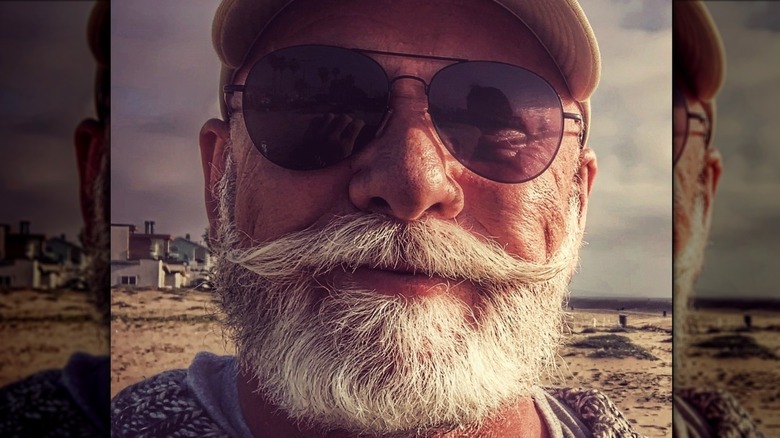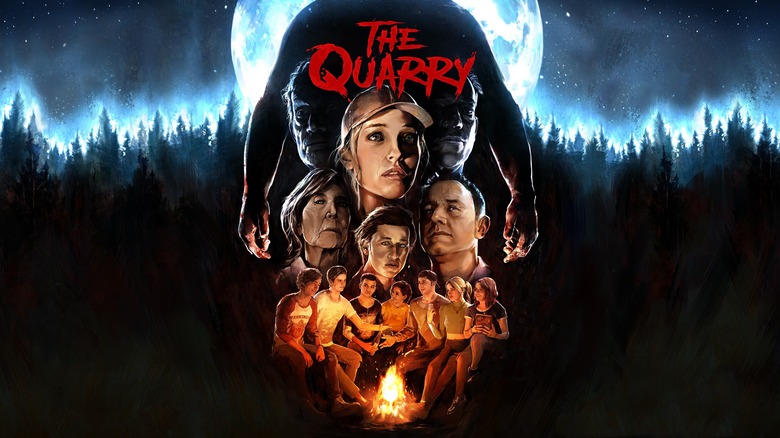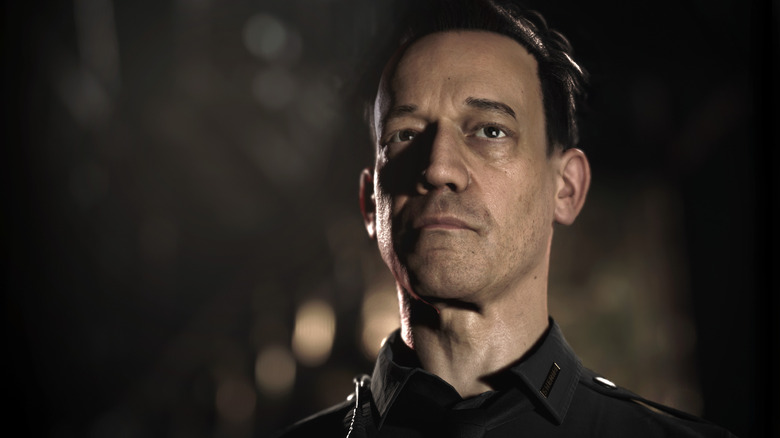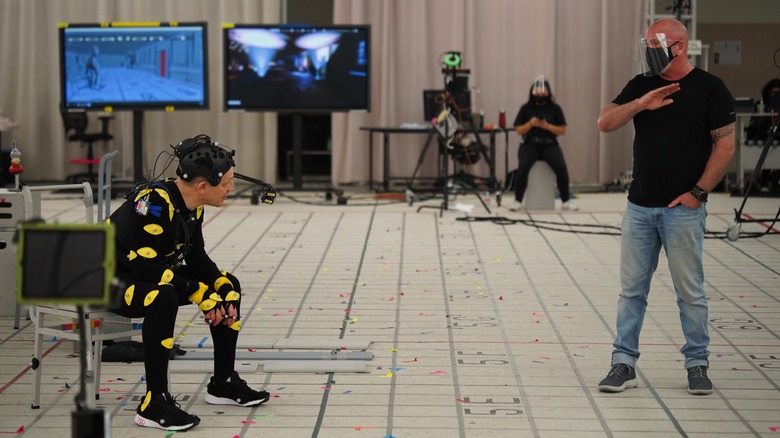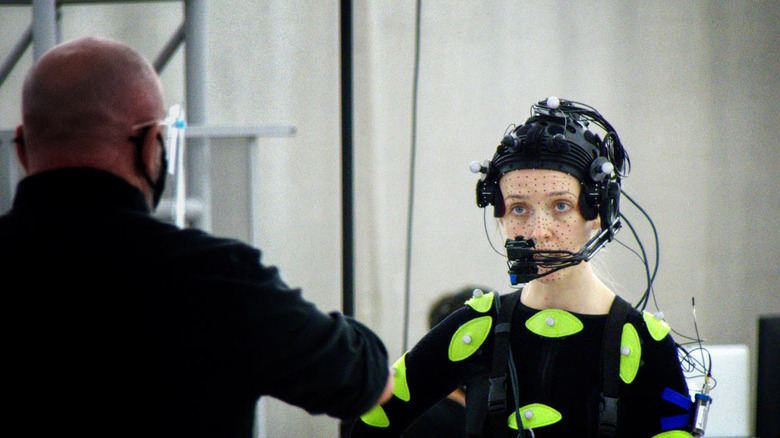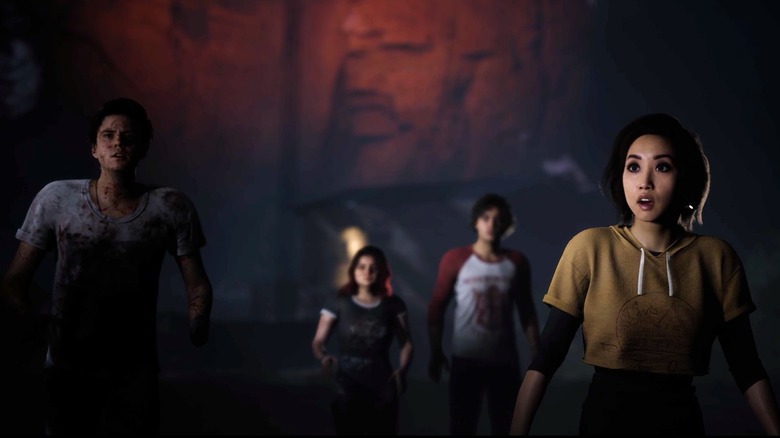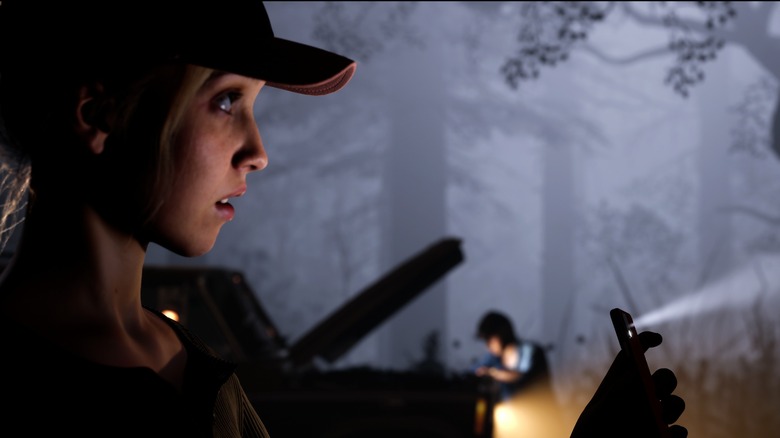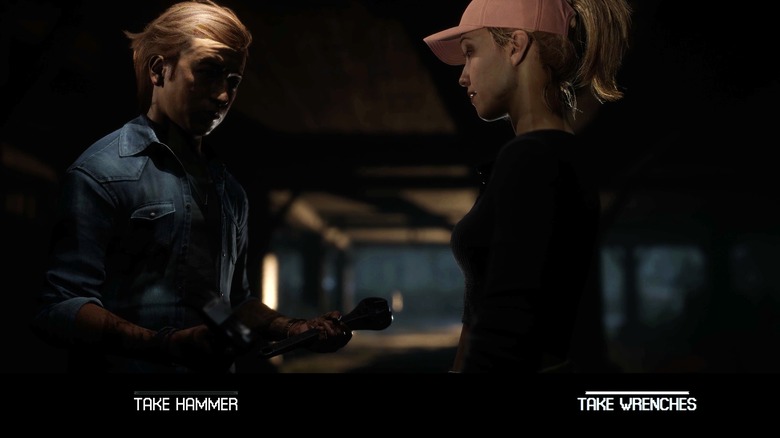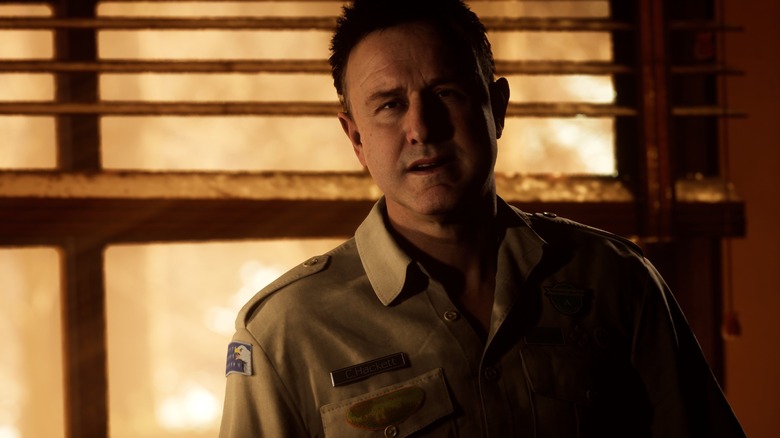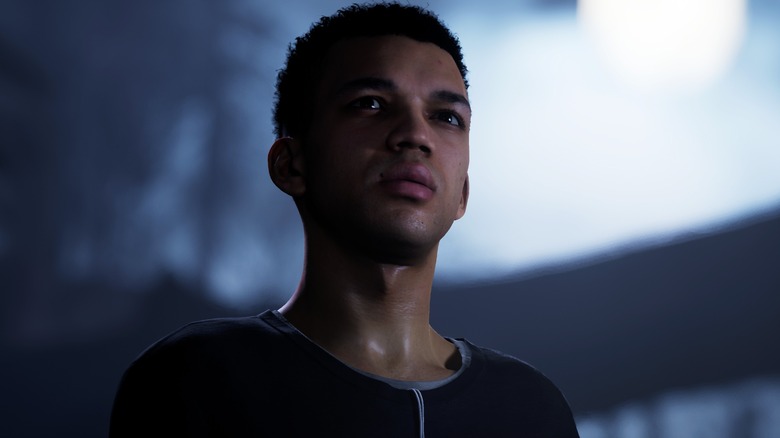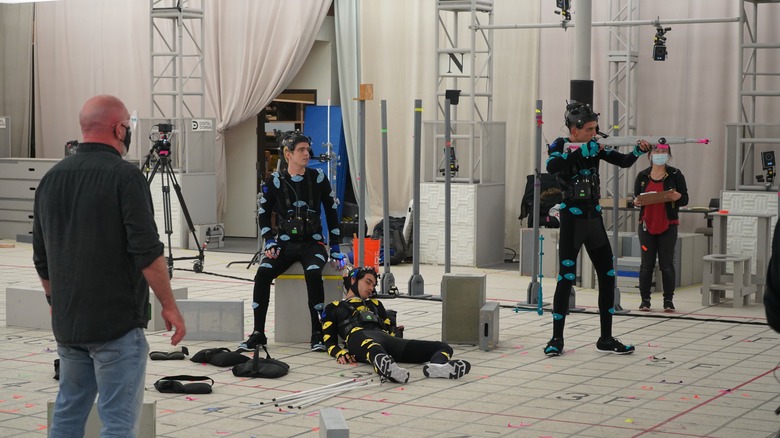Director Will Byles On The Quarry, Until Dawn, Horror Film Inspirations, And More - Exclusive Interview
This article includes spoilers for "The Quarry."
In 2015, writer-director Will Byles' interactive horror video game sensation "Until Dawn" was released, which followed the plight of eight young adults as they attempted to survive a terrifying night on Blackwood Mountain until the new day's dawning. Developed by Supermassive Games, "Until Dawn" became a massive blockbuster worldwide, leaving players patiently anticipating what Byles and his bands of creatives would put out next.
Seven years later, Byles is back with a new horrifying interactive experience with "The Quarry," which like "Until Dawn," follows a group of a young adults trying to survive a horrific night. Developed by Supermassive Games and published by 2K Games, "The Quarry" is an interactive video game rooted within a cinematic narrative, where nine camp counselors encounter terror at the campgrounds at Hackett's Quarry in the remote woods in upstate New York. In addition to facing the twisted members of the Hackett family, the counselors — depending on the decisions gamers make — also are subject to a curse that will lead them to explosively transform into a werewolf.
Like "Until Dawn," which featured the likes of Rami Malek and Hayden Panettiere, "The Quarry" boasts an impressive cast, including Ted Raimi, Siobhan Williams, David Arquette, Ariel Winter, Skyler Gisondo, Lin Shaye, and Lance Henriksen. In an exclusive interview with Looper, Byles talks about his work with the actors and how their roles came to life via motion capture. He also discusses the similarities and differences between "Until Dawn" and "The Quarry," the horror films that influenced his new video game opus, and more.
Byles says Scooby Doo helped him imagine the roles in The Quarry
Visually, where does the process for a game like "The Quarry" start? Does it start with storyboarding? That, to me, might be complicated too, because with a video game, we're talking about players taking different paths for duration of the game. It seems like it would be quite different than a filmmaking venture.
It's not a million miles away, other than in its scale and complexity. The first thing that happens is I write a screenplay — a 90-page, 100-page screenplay, single path all the way through — with pretty much every single scene that's in the game in it. With dialogue, I start to try and flesh them out a little. They start off very primary colored and so there's "the jock" and there's "the cheerleader." Then, there's "the nerdy kid" and "the weird police guy."
That's how I start the whole thing out. There's also "the dodgy, local family with the matriarch" and the "scary, weird, slightly lupine patriarch."
All of that stuff was in there. Weirdly, as well, I very lazily, I suppose, start them all often in "Scooby Doo" roles. Laura [Siobhan Williams], for instance, her role very early on — she was one of the very first characters, because she's right at the beginning of the story — she was a Velma character. She was this slightly more matter-of-fact, to get her nose down and try to and understand stuff. There's a couple of times we even got her saying "Jinkies," and that's how it starts.
Once we start to really expand that, it takes a team of people to start working on how the branching goes on. Fundamentally, that is every single beat of the story. Then, as a writer does, [you start asking yourself questions, like], "Well, yeah, but what if? What if I go a slightly different direction? What if I do the exact opposite of that?" You start to explore what the branches can be, and once you start to get to that stage, then you end up in a fairly strong story.
Raimi brought more to his creepy role than Byles could have imagined
Ted Raimi is one of the many great actors in the cast. At what point do the characters like Ted's Sheriff Travis start to come to life for you?
The point at where we get to casting and you start to have a look around, that's when it all really starts to get interesting and the characters really take on a life of their own. Once we got to the read-through — the table read — Ted came along and bought [his actor's sensibilities] with him, and it changed everything. Travis became a much rounder character. The character development was really nice. Everything that he was working on, we took back a little bit and altered some of the dialogue, just because of the way his voice was.
Ted has amazing pacing. He pauses a lot. It's almost like a famous pause. He'll say something and look away, and you can see him thinking. Even in the CG world, you can see him thinking and then come back, like there's a little journey that's happened there. He's fantastic at that. All the actors are. The way I like to direct, really more than anything, is to get a good actor to start things off and let them be good at what they do. They bring so much more than I could think of to a character.
Taking the next big step
Video game technology seems to be evolving daily. Was there a particular point in directing "The Quarry" where you sat back and you said, "You know what? I really took a big step here" taking you beyond a place, maybe, you wouldn't have envisioned a year ago?
When we first started on "The Quarry," we had already worked on "Until Dawn," and even during "Until Dawn" we really pushed some boundaries. There was a company called 3ateral, and they've just started this real scan and a 4D scan system for facial animation. That's what we did with them. No one, even in those stages, had really, in games, used a blend shape system in the way that we did on this.
Usually, all the faces are driven by little bones — not real bones, but CG bones. That allows for lodding [a process of rendering an object with a higher resolution], where if you've got 100 people in, you can dial down the number of vertices on a face. With this, you can't or you couldn't. It's always been avoided, but because we were making a much more filmic thing, we thought, "We can be editorial in our framing. If you can't have 20 people on stage, let's get a tighter lens and have one person, and then, it'll work." We did that in "Until Dawn."
What I really want to do, and a big part of what we try to do, is avoid any disruption in the suspension of disbelief. That usually comes when you hit the uncanny valley [phenomenon] where things aren't looking quite right or there's something weird going on. To avoid that, we're trying to push the boundaries on the level of verisimilitude as you play the game.
The closer it looks to film, the less likely it is you'll be thrown with a jarring [feeling of], "That doesn't make sense" ... With this, I went to this yearly thing called SIGGRAPH, which is where all the real, super clever companies all gather together, usually in Vancouver, and show off [their new technology] to each other.
An Avengers villain led Byles to pursue the motion capture technique used in The Quarry
What do you feel was the turning point for you at SIGGRAPH?
Two or three years ago, I went there and I was watching the Digital Domain stuff. They just finished Thanos [in "The Avengers: Infinity War" and "Endgame"], where they'd been doing a really unbelievable job with a machine learning [engine] to do the animation. Previously, we still had animators, but this machine learning thing was extraordinary.
With Thanos, it was like, "That's Josh Brolin." Regardless of the fact that he's got this giant chiseled pink chin, you could see it is Josh Brolin. His mannerisms were there, the nuance was there, and the subtlety of performance was there. Everything was there. It seemed like, "If we could get that, we'd be really hitting something." We had long discussions with them. It wasn't suitable for games yet ... but we carried on our talks with them.
We had the luxury of a three-year window to make "The Quarry," and we had at least a year to really try out the process. We could always have fallen back on the process that we did with "Until Dawn," because we knew that was good, but it wasn't the best it could be in the world. The Digital Domain stuff was, but we didn't know it would work in a game, so we pushed things with them.
They were super accommodating. They invented a whole bunch of stuff specifically around ["The Quarry"]. Even toward the end, they were still inventing some bits and pieces to make things work and catch as close to a captured performance as possible — and not a single animator was involved in any of it. It was all done with their system and their machine learning [engine].
The similarities — and differences — between Until Dawn and The Quarry
I know some video game outlets are calling "The Quarry" a spiritual successor to "Until Dawn," and it's definitely not a sequel. How hard did you have to rack your brain to ensure players were getting an entirely new gaming experience with "The Quarry"?
The game is a bit of both, really. For part of "The Quarry," we wanted it to be completely new, but for part of it, we wanted it to be exactly the same [as "Until Dawn"]. With something like "The Quarry," we're not really reinventing the wheel. There are technology advancements for the rendering and the capturing stuff, but the real thing we wanted to do is to entertain people.
We looked at the stuff we did in "Until Dawn." We looked at mostly the positive comments, because you want to keep the stuff that people loved in it, but we also wanted to see where things hadn't gone quite so well in "Until Dawn" and improve on that. The number of endings, for instance, in "Until Dawn," was always a little bit of a criticized area. We thought, "Let's go to town" [with "The Quarry"].
It's about putting content forward with a style. That was a really important thing. "Until Dawn" has a lightness to it. I don't mean it's comedy. It's not that. It's that it doesn't take itself very seriously. It's very much a teen horror story in the context of it being slightly self-referential. It knows what it is.
Therefore, you can take the whole thing that happened with "Scream," where it becomes [slightly] post-modern, like I say, "self-referential." It knows that it has got this rule set and within that rule set, there's a number of things that you can do and a number of things you can't do, and if you are given those things, as a rule set, then we can then muck about with that as authors, effectively. Then, we take you on different journeys and allow you to switch and swap between the two.
We wanted to try and keep that lightness and keep that humor there for "The Quarry." In fact, we wanted to push it a little bit further, more along the lines of the TV series "Supernatural" rather than the movie "Hostel" or something like that, because again, it's not comedy, but [there are] little one-liners every now and again, and that was a big part of it.
Some of our other games have been more serious. That's where the "spiritual successor" thing comes in — to go on with a bunch of teenagers with a lightness of touch and not take ourselves very seriously. When one guy gets his arm chopped off by a chainsaw by another guy ... it is an absolutely ridiculous way to deal with somebody's injury, but it's straight out of "The Evil Dead" playbook. It's stupid and funny and horrible, but you can go along with it because that's the journey we wanted to take you on.
Byles says watching reactions to The Game on Twitch is 'super gratifying'
How exciting is it for you to be on Twitch and see reactions to the game? As close as you are to the making of "The Quarry," it still must be a real hoot for you to watch people playing it and watching them jump and get scared.
It's brilliant. I can't stop watching this. Yeah, it's quite vain, but there's a definite fun thing about watching reactions to a few little bits and pieces in there. There's one ridiculous joke that we have in which is where [two counselors] are trying to call for help. Dylan [Miles Robbins] makes up a whole bunch of rubbish and talks about [how] there's a flock of bears after them. Ryan [Justice Smith] goes, "It's a herd of bears," and then Dylan turns around and goes, "Yeah, I've heard of bears." It's a stupid little joke, but seeing people's reactions to stuff like that is super gratifying.
[It's also exciting watching] people make choices in scary situations ... We did a choice in "Until Dawn" and we actually mirrored it in "The Quarry." In "Until Dawn," it was Ashley (Galadriel Stineman). We put her in a situation where she's with her friends, walking through some obviously scary caves and she hears the voice of her dead friend calling her. You have a choice there to either go and see what's going on or stick with your friends.
The obvious thing to do is, if you hear a voice of your dead friend, you ignore that. Why would you go down there? Stick with your friends. A lot of people sort of switched on that idea and went down there, and they carried on, but there's a point where it carries on further and you can turn back. Then, you also come across a trap door and the trap door's banging on the ground, and you have a choice to walk straight past it and leave it or open it. If you open it there, a thing comes up and takes your head off straight away and it serves you right because you were so warned along the way about what would happen, and you knew what would happen.
We do the same thing in "The Quarry." We have the same scenario and this time we even have the character say, "If I open this trap door, I will die immediately" to her phone, because she's doing a vlog. It is massively gratifying to watch.
Venturing into the Wolf Pack Multiplayer Mode
"The Quarry's" Wolf Pack Multiplayer Mode was added to the game post-launch. Were there any features left on the cutting room floor that didn't make it into the final version of multiplayer?
We looked at a whole bunch of stuff for multiplayer. The real joy about these games for me is when you play it with other people. We designed them around the idea of players sitting on a couch with a couple of beers, watching it like you would a horror movie. It's rare that people watch them on their own. Sometimes they do, but it's much more fun when people are shouting around you and stuff ... and that was what we wanted to try and get across in multiplayer.
We've also got multiplayer on some of our other games where it's much more, "Okay, we've got two different characters playing different roles" and you go off doing different things. My feeling is, I enjoy that less. It's definitely a more complicated way of writing. You have to allow for the single player version and the multiplayer version, and ultimately, you are not doing the same sharing. It only works if you separate out and one person's going one way and one person's going the other.
We've had a look at a whole bunch of these things. The biggest challenge to these games is to try and make a satisfying story across hundreds of paths. Depending on the variations of what's going on — whether or not Laura ended up completely covered in blood and getting her head cut off by Travis, or that they share the ending and go off and kill the main monster — all of those things are really complicated to try and get to a place where everybody's satisfied on that.
We made it more complex by adding what we thought would be a thrill at the end, as opposed to just allowing people to share the game. We didn't lose much on that. I can't think that there was anything in there that we went, "I wish we could do this," partly because we've done it before. Actually, this still, for me, is the main point of it.
Evil Dead 2 and horror classics was hugely influenced The Quarry, Byles says
You mentioned "The Evil Dead" earlier. What's your favorite horror movie and how did its influence creep into "The Quarry"?
I've got to say "Evil Dead" — well, "Evil Dead II" is probably my favorite. I love "Evil Dead," but "Evil Dead II" has the bigger budget. It is genius. I massively, hugely admire Sam Raimi. He's an incredible filmmaker, so definitely that's one.
One of my other top five films is "An American Werewolf in London" from John Landis. There are a few nods to that in "The Quarry." A [college rejection] letter in the game is from Landis University. ["An American Werewolf in London" is] a genius film and we paid homage to a large part of that, including the music style of the game. We've used a lot of [Landis' style of] incongruous, slightly oddly felt juxtaposition with light, frothy music and really nasty horror. That was really important that we went down that route.
There's a little stable of the classic slashers [that influenced the game]. There's "Friday the 13th," which is the whole summer camp thing ... There are also homages to "The Hills Have Eyes" and "Deliverance" — what they call "killbilly" movies or "hick flicks," so there's that side of it. We purloined little bits and pieces from all of these things.
One of my favorite films, I'd say a top three pick, is an old black-and-white film from 1963 called "The Haunting." It was fantastic. It was genuinely scary at the time. If you watch it now, it's less scary only because everything ever done since has been stolen from that. It was genius. It was Robert Wise who directed it. Robert Wise was an amazing filmmaker. It's genuinely one of the scariest films ever made.
They've remade it recently. They made a dreadful one in 1999, which was awful, and they've remade it recently as a TV series [Mike Flanagan's "The Haunting of Hill House"], which was fantastic as a much bigger story, even if it wasn't the original story. Robert Wise was a great director and "The Haunting" was a seminal horror film. The next film he made was "The Sound of Music," and he also directed "West Side Story."
Creating characters that are 'bursting to get out'
Where did you come up with the idea for the werewolf transformations in "The Quarry"? I can't recall seeing a werewolf transformation like this before. Maybe it could be considered close to "Van Helsing," where the character would tear his flesh away to expose the beast, but it is much more explosive — quite literally — the way it happens here.
We had so many meetings about this and we went through all sorts of stuff. There's "An American Werewolf in London," which has the seminal changing [of a man into a werewolf], which was fantastic. It was all done with an amazing set of practical effects. With CG, it's a lot easier now. Every single one of the wolves in "The Quarry" is based on the actual character, even though you might not see it.
I [thought], "Okay, what are we going to do with these things" [when it came to their transformations]? I'd also recently seen "Ready or Not," where, at the end, I don't want to spoil it, in case you haven't seen it—
I've seen it, but yeah, I know where you're going with this!
Yes, and it's funny. Seeing people exploding is bizarrely funny, even though it's not. It's horrible and it's full of grossness, but there's something really shocking about it. Like you say, there was "Van Helsing," where he is ripping all this stuff off and that was really cool. It felt like it was visceral. The werewolf thing, it's quite ethereal, but actually bizarrely ethereal.
You are in the realms of magic now, rather than actual horror. There's a magic spell that's happened. How that works has to be subjective in a way, and this felt like, "You have something inside of you that's bursting to get out," and we felt like that would be really good. It was much harder to do than we thought it would be. We thought, "Press the explosion button and that'll be fine," but it was harder than that to try and get that feeling of pressure on the inside.
Byles prefers the emotion of video games over films
Since "Until Dawn" and "The Quarry," are both massive hits, I'm sure you've been offered opportunities to direct feature films. Would you consider that avenue at some point or would you like to just remain in the gaming world? To me, it just seems like you're offered an opportunity for so much more creativity with video games.
Yeah. It's weird. Yes, you're right, and it's an interesting thing. Still now, people are asking me to do films. It's a difficult thing. It's a choice, because the feature films are exciting. They bizarrely, compared to making a game, would be quite easy [to make] ... It's a dreadful thing to say, but [with films you get] an hour and a half [run time], and with every single shot, you know what it's going to be. With the games, you're talking about playing 10 hours, and every single shot has to cut with other shots that may or may not come along.
However, there is something with games — we are breaking new ground, not just in the technology, but in the level of storytelling and the idea that you're working in a narrative where you can use actual first-person emotion. With feature films and books and anything else, wherever it's a passive medium, it has to be a third-person emotion. It has to be a vicarious thing where you are watching and you have an empathy with what you're watching.
You can get very close to empathy, but you could never have guilt. You can't watch something and go, "Oh, s***. I feel really guilty about that," because you didn't do anything. You can feel bad for your protagonist, but with games, you absolutely can feel guilt. You've just shot your best friend, because you thought they were [evil] ... There's something about the emotional journey that you can do in games that we are really just poking around.
It's almost like the early Russians and montage editing back in "The Battleship Potemkin" stuff. That's where we are in games ... where it's real. Some of it works and some of it doesn't, but being there is really exciting.
"The Quarry" is available in stores and online from Supermassive Games and 2K Games.
This interview has been edited for clarity.

